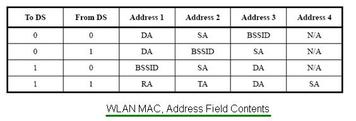11ac Wave1 vs. Wave2: Key Differences in WLAN Standards
Explore the distinctions between 802.11ac Wave1 and Wave2, including channel bandwidth, speed, and beamforming capabilities. Understand the evolution of WLAN technology.
Showing 22 posts (Page 1 of 1)
Advertisement
Explore the distinctions between 802.11ac Wave1 and Wave2, including channel bandwidth, speed, and beamforming capabilities. Understand the evolution of WLAN technology.

Explore 4096-QAM modulation in Wi-Fi 7, including its benefits, drawbacks, and applications in high-bandwidth wireless communication.
A comparison of 802.11a, 802.11b, 802.11g, and 802.11n Wi-Fi standards, outlining differences in modulation, data rates, frequencies, and range.

Explore the WLAN MAC protocol with a focus on the 802.11 WiFi MAC frame format, including the MAC header, body, and FCS fields.

Explore the structure and functionality of 802.11 WLAN MAC frames, including control (ACK, RTS/CTS), data, and management frames (authentication, association, beacon, etc.).

Explore the 802.11n wireless networking standard: frame structure (legacy, mixed, greenfield modes), physical layer components, and key functionalities for increased data rates.
Explore the key differences between 802.11n, 802.11ac, and 802.11ad Wi-Fi standards, covering frequency, data rates, and applications.
Explore the evolution of IEEE 802.11 standards (Wi-Fi), from legacy versions to the latest Wi-Fi 6 and upcoming Wi-Fi 7, detailing their features, data rates, and applications.

An overview of IEEE 802.11ac WLAN technology, covering key features like bandwidth, MIMO, modulation, and frame structure.

Explore the IEEE 802 standard family for LANs, MANs, and WANs, including 802.11 (WLAN), 802.15 (Zigbee, Bluetooth), and 802.16 (WiMAX).

Learn Wi-Fi 7 MU-MIMO basics and explore advantages or benefits of MU-MIMO.

Learn Wi-Fi 7 Multi-RU and Preamble Puncturing.Explore difference between them including benefits of puncturing.
This article on Wi-Fi 7 network planning covers site survey, RF link budget and deployment guide including tools and Access Point (AP) Selection.
Learn how Wi-Fi 7 improves QoS with MLO, R-TWT, TSN-inspired scheduling for low latency, efficiency and reliability across wireless deployments.

Explore WiFi 7 architecture, including PHY/MAC layer enhancements, MLO, and benefits like higher data rates, reduced latency, and improved spectrum efficiency.

Explore WiFi 7 Extremely High Throughput (EHT) frame structure based on IEEE 802.11be, including preamble, EHT-SIG fields, and data field enhancements.

Explore the WiFi 7 MAC layer advancements, including multi-link operation, enhanced MU capabilities, and frame structures for efficient AP and STA communication.

Explore WiFi 7 PPDU Formats and their fields as per 802.11be including HE MU PPDU, ETH MU PPDU, HE TB PPDU and ETH TB PPDU.
This page covers RF and PHY conformance tests for 802.11n and 802.11ac devices, including transmitter and receiver measurements.
Explore RF PHY layer testing for IEEE 802.11ad, covering transmitter and receiver conformance tests crucial for 802.11ad product evaluation.

Explore the WLAN physical layer, focusing on the IEEE 802.11 standard, frame structure, OFDM, and transmitter/receiver architectures for WiFi networks.

Explore WLAN security basics, including the WEP protocol, RC4 encryption, authentication methods, and a practical WiFi security checklist.
Advertisement